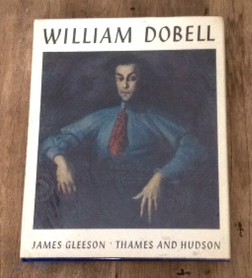Inspiring Older Readers
 posted on 22 Jul 2016
posted on 22 Jul 2016
William Dobell by James Gleeson
Here’s a party game suggestion for you : name five famous Australian artists. Ok, I’ll give you Sidney Nolan, Shaun Tan and maybe Helmut Newton.......do you really want to claim Rolf Harris? Bet you’re struggling now. I certainly would have been if I hadn’t stumbled over this book of the works of William Dobell.
Born in 1899 in Newcastle, New South Wales, Dobell was one of six children from a very working class background and his father, a builder , struggled to support the family. By the time he was 16 his artistic capabilities had been spotted and he got a job as a draughtsman in an architect’s office while he went to evening classes at Sydney Art School.
In 1930 he won a scholarship to come to the UK where he studied at the Slade and won awards for his figure painting. By 1931 he felt the need to move on and travelled widely in Europe for a decade before going back to Australia.
While his reputation continued to rise in Australia, the reception of his work by the public was mixed and there were many who were puzzled by and objected to what they saw as caricature rather than portrait work. These criticisms had a pronounced negative impact on Dobell’s confidence and he moved from portrait work to landscape, travelling widely in New Guinea to record the countryside and the indigenous population. More domestic awards followed and he died in 1970 leaving his estate to the William Dobell Foundation which he had established.
Dobell’s style is really difficult to pin down and I think it shows the breadth of influences he came under. For me, the portraits are a triumph because they are full of character – I think it’s easy to see the influence of artists like Stanley Spencer in these paintings and are clearly products of an artist influenced by European Modernism.

The text in this book has been written by James Gleeson, himself an Australian artist with a significant reputation in his home land. I found it very accessible and not overly detailed – he focuses more on the artistic value and merits of Dobell’s painting. His assessment of Dobell is worth quoting here:
"One of the astonishing things about Dobell's portraiture is his ability to adjust his style to the nature of the personality he is portraying ... If the character of his sitter is broad and generous, he paints broadly and generously. If the character is contained and inward looking, he uses brushstrokes that convey this fact. In his later portraits one has only to look at a few square inches of a painted sleeve to know what sort of person is wearing it."
The book these illustrations are taken from is the Thames and Hudson hardcover printed in 1964 and which contains colour reproductions which have been tipped-in and fewer black and white photographic reproductions. Copies of the book can be picked up on the second hand market for about £12 - £15. If, like me, your knowledge of Australian art doesn’t really go much past Sidney Nolan, this is a good place to start expanding your knowledge.
Terry Potter
July 2016





